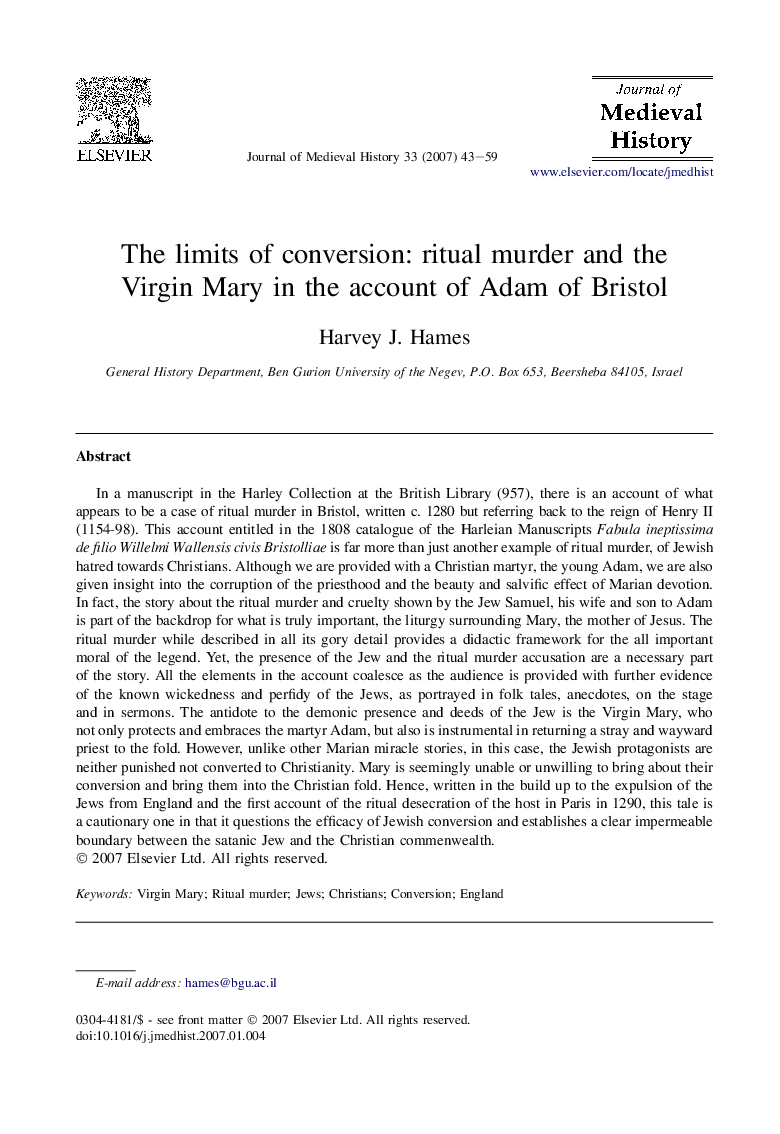| کد مقاله | کد نشریه | سال انتشار | مقاله انگلیسی | نسخه تمام متن |
|---|---|---|---|---|
| 1160005 | 959749 | 2007 | 17 صفحه PDF | دانلود رایگان |
عنوان انگلیسی مقاله ISI
The limits of conversion: ritual murder and the Virgin Mary in the account of Adam of Bristol
دانلود مقاله + سفارش ترجمه
دانلود مقاله ISI انگلیسی
رایگان برای ایرانیان
موضوعات مرتبط
علوم انسانی و اجتماعی
علوم انسانی و هنر
تاریخ
پیش نمایش صفحه اول مقاله

چکیده انگلیسی
In a manuscript in the Harley Collection at the British Library (957), there is an account of what appears to be a case of ritual murder in Bristol, written c. 1280 but referring back to the reign of Henry II (1154-98). This account entitled in the 1808 catalogue of the Harleian Manuscripts Fabula ineptissima de filio Willelmi Wallensis civis Bristolliae is far more than just another example of ritual murder, of Jewish hatred towards Christians. Although we are provided with a Christian martyr, the young Adam, we are also given insight into the corruption of the priesthood and the beauty and salvific effect of Marian devotion. In fact, the story about the ritual murder and cruelty shown by the Jew Samuel, his wife and son to Adam is part of the backdrop for what is truly important, the liturgy surrounding Mary, the mother of Jesus. The ritual murder while described in all its gory detail provides a didactic framework for the all important moral of the legend. Yet, the presence of the Jew and the ritual murder accusation are a necessary part of the story. All the elements in the account coalesce as the audience is provided with further evidence of the known wickedness and perfidy of the Jews, as portrayed in folk tales, anecdotes, on the stage and in sermons. The antidote to the demonic presence and deeds of the Jew is the Virgin Mary, who not only protects and embraces the martyr Adam, but also is instrumental in returning a stray and wayward priest to the fold. However, unlike other Marian miracle stories, in this case, the Jewish protagonists are neither punished not converted to Christianity. Mary is seemingly unable or unwilling to bring about their conversion and bring them into the Christian fold. Hence, written in the build up to the expulsion of the Jews from England and the first account of the ritual desecration of the host in Paris in 1290, this tale is a cautionary one in that it questions the efficacy of Jewish conversion and establishes a clear impermeable boundary between the satanic Jew and the Christian commenwealth.
ناشر
Database: Elsevier - ScienceDirect (ساینس دایرکت)
Journal: Journal of Medieval History - Volume 33, Issue 1, March 2007, Pages 43-59
Journal: Journal of Medieval History - Volume 33, Issue 1, March 2007, Pages 43-59
نویسندگان
Harvey J. Hames,